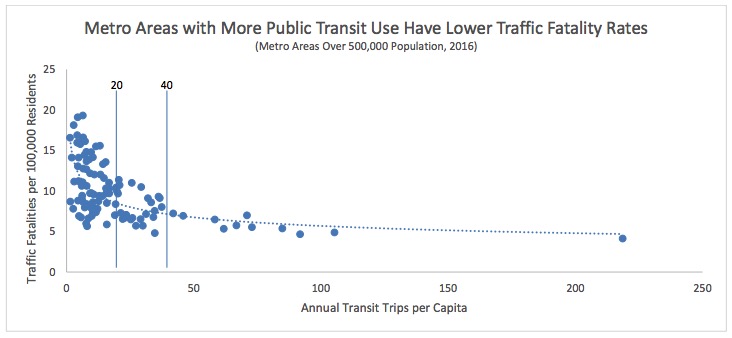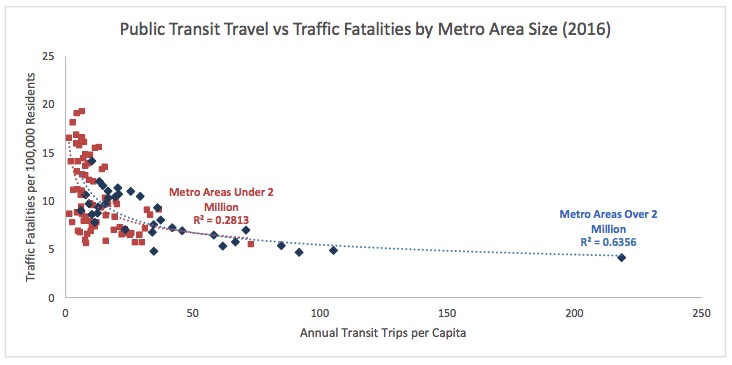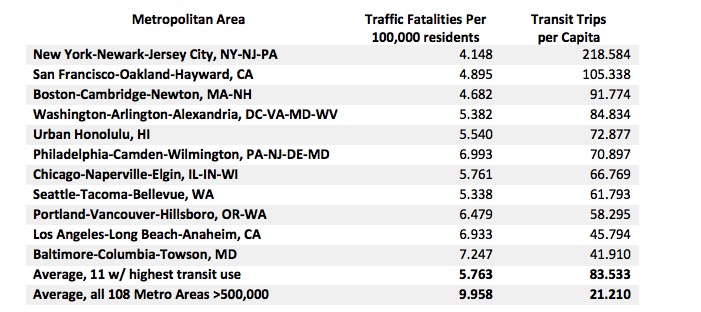AMERICAN PUBLIC TRANSPORTATION ASSOCIATION (APTA)
As the movement toward Vision Zero grows – with more than 30 U.S. communities committing to the goal of zero traffic deaths – public transit is increasingly recognized as a core strategy to support safe mobility for all.
Public transportation is one of the safest ways to travel. It is ten times safer per mile than traveling by car because it has less than a tenth the per-mile traffic casualty (injury or death) rate as automobile travel.
New Analysis Shows Link Between Public Transit & Safety
APTA Policy analysis of recent National Highway Traffic Safety Administration (NHTSA)3 and Federal Transit Administration (FTA)4 data shows that metro areas with higher public transportation use have lower traffic fatality rates. Those metro areas with more than 40 annual transit trips per capita have around half the traffic fatality rate of metro areas with fewer than 20 transit trips per capita.
Advancing Vision Zero with Public Transit Boosts
Vision Zero is a strategy to eliminate all traffic fatalities and severe injuries. Started in Sweden 20 years ago, it has been adopted by more than 30 communities in the U.S. during the past four years, showing promising early results. While NHTSA data shows that there were 37,461 traffic fatalities in 2016 – a 5.6 percent increase over the previous year – in the two longest-running Vision Zero cities, traffic deaths have decreased significantly. Traffic deaths in New York City are 28% lower and in San Francisco 41% lower in the four years since each committed to the Vision Zero approach in 2014.
Increased public transportation use helps further Vision Zero goals of reducing traffic fatalities. Research shows that modest increases in public transit mode share can provide disproportionally larger traffic safety benefits. An increase from 20 to 40 annual transit trips per capita represents a small change in behavior—simply taking two more public transit trips per month.
This suggests that typical U.S. urban regions can reduce their traffic fatality rates 10-40% by making public transit a higher priority, in conjunction with various support strategies such as pedestrian and bicycling improvements, commute trip reduction programs, efficient parking management, and transit-oriented development policies. The largest benefits are likely to be achieved in the most automobile-dependent communities.
The relationship between higher public transit use and lower traffic fatalities is especially strong for metro areas with populations over 2 million. For the 34 metro areas with more than 2 million residents, the statistical relationship is stronger (R^2 of 0.64) than for metro areas between 500,000 and 2 million residents (R^2 of 0.28).
The 11 metro areas with over 40 transit trips per capita have relatively low traffic fatality rates, as seen in the table below.
Who Benefits from Safety Impacts of Public Transit?
- Public transportation investment and supportive policies increase traffic safety in several ways, including:
- Factors that increase public transit use, like compact development and good walking and bicycling connections, tend to decrease traffic fatalities.
- Travelers who shift from automobile to public transit directly reduce their crash risk.
- High risk groups like young drivers, seniors, alcohol drinkers, and compulsive texters, are more likely to reduce their driving if alternatives like public transit are convenient.
- Less total vehicle travel leads to community-wide crash reductions.,
- Lower and safer traffic speeds make it safer for public transit users to get to their stop or station.
Since most casualty crashes involve multiple vehicles, even responsible drivers who always observe traffic laws and never use public transit benefit from public transportation improvements that help reduce higher-risk driving, and therefore their risk of being the victim of other drivers’ mistakes. Public transportation modes that serve longer trips can help reduce total vehicle travel and provide safety benefits to users. Traveling by commuter and intercity rail is 18 times safer for passengers (measuring fatalities) than traveling by auto.
High-risk groups – including young drivers, seniors, alcohol drinkers, and compulsive texters – are more likely to reduce their driving if alternatives like public transit are convenient and attractive. This is significant, given that motor vehicle crashes are the leading cause of death for U.S. teenagers, according to the CDC, and “the risk of motor vehicle crashes is higher among 16-19-year-olds than among any other age group.” The CDC also says that for seniors, the risk of being injured or killed in a motor vehicle crash increases with age. In addition, about one in three traffic deaths in the United States involves a drunk driver. Fatalities from distracted driving have risen over the past 6 years, and texting while driving is especially dangerous.
Moving Forward
Given that traditional traffic safety programs generally overlook public transportation as a potential safety strategy, the new and transformative approach of Vision Zero offers a prime opportunity to promote and expand the use of public transportation as a proven effective tool to help move our communities toward zero deaths and injuries on our roadways.
This analysis is based on the methods used in the APTA publication The Hidden Traffic Safety Solution: Public Transportation. APTA is pleased to partner with the Vision Zero Network to share promising strategies for greater coordination and cooperation between transit professionals, Vision Zero proponents, and others interested in safe mobility for all. For more information, go to www.apta.com/safety.
About the American Public Transportation Association (APTA)
www.apta.com
To strengthen and improve public transportation, APTA serves and leads its diverse membership through advocacy, innovation and information sharing. APTA and its members and staff work to ensure that public transportation is available and accessible for all Americans in communities across the country.
Tags: American Public Transportation Association, APTA, safety









 RSS Feed
RSS Feed